When it comes to sex and social media, the line between appropriate and potentially offensive has been murky, inconsistent and, more and more often, seemingly discriminatory. We’re in uncharted waters with this relatively new technology, but many, especially in the LGBTQ community and sex industry, fear that we’re heading down a slippery slope that risks setting us back, countering the cultural progress we’ve made in acceptance of and attitudes about sexuality.
Just this past summer, Facebook and Instagram limited users from posting the eggplant and peach emojis in reference to sexual statements via an update to their Community Standards guidelines, and the past year has seen the fight for sexual expression go into high gear as users find themselves in “Facebook jail,” or limited by an “Instagram suspension,” due to content that someone or more likely, some algorithm, at the platform thinks too provocative.
Which brings us to Tom of Finland. For those unfamiliar, the Tom of Finland Foundation is a non-profit that has worked towards “protecting, preserving and promoting erotic art” for the last quarter century. The foundation was started in 1984 by Touko Laaksonen, better known by his pseudonym Tom of Finland, an erotic illustrator from Helsinki (originally from Kaarina, Finland). Tom of Finland’s work as an artist and his work with his nonprofit were instrumental in shaping 20th-century gay culture and his impact is still being felt today. ToF has been active on social media since its beginnings, and its content has not changed, but last month the foundation saw its account banned from Instagram. It was reactivated within 18 hours after public outcry, but there remains a lack of clarity about why it happened to begin with.
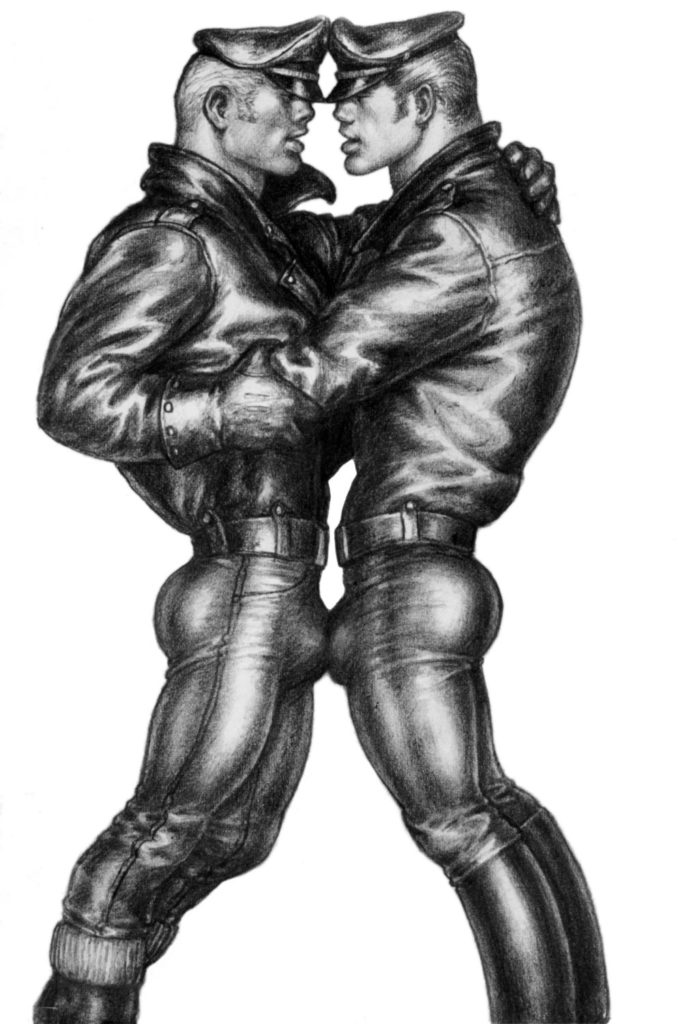
(Courtesy Tom of Finland Foundation)
Though Instagram’s guidelines state that, “nudity in photos of paintings and sculptures is OK,” the “Free the Nipple” movement, backed by several celebrities on and off the platform, has been pointing out IG’s inconsistencies for a few years now. Breastfeeding and mastectomy shots have been allowed — which is progress — but the sexism inherent in allowing shirtless male images versus female is still present. The way the platform has handled LGBTQ content is even more problematic, and while the outright banning ToF suffered was a big setback, it’s mobilizing the community, as well as the queer artists associated with it. That Tom of Finland is ready to fight on the frontlines against censorship is not new; it’s what the art itself is and always has been all about.
Laaksonen never went to art school, instead moving to Helsinki when he was 19 to start a career in advertising. He came of age fighting in the Finnish army, defending his country against the Soviets during World War II. (His fellow soldier’s uniforms would end up playing a big role in his artwork and in defining his style).
“Tom drew loving couples and groups engaged in intense scenes — all sex positive,” says S.R. Sharp, the Tom of Finland Foundation’s vice president and curator for the last couple of decades. “He drew a world so desirable that we started dressing like it, playing like it — living like it.”

(Courtesy Tom of Finland Foundation)
In fact, Tom of Finland’s drawings went hand in hand with the emergence of the gay leather scene in London’s undergound in the ’50s and ’60s. “Tom was certainly there. He was associated and friends with one of the early physique photographers who captured a lot of the leather scene,” says Sharp. “I’m not going to say he was the creator, [but] I will say he was part of it. And because he rendered leather so well and he captured it so well in drawings, I think his work became iconically associated with [its] beginnings.”
Laaksonen viewed his homosexuality as a non-issue, and wanted to normalize it for everyone else in his community at a time when being gay was literally a crime. “In those days, a gay man was made to feel nothing but shame about his feelings and his sexuality. I wanted my drawings to counteract that, to show gay men being happy and positive about who they were,” the 71-year-old explained before he died in 1991 from an emphysema-induced stroke. “I didn’t sit down to think this all out carefully. But I knew — right from the start — that my men were going to be proud and happy men,” he added.
Indeed, “Tom’s Men” as they came to be known, were pretty much the first sex-positive modern art figures depicting the LGBTQ community. No doubt many have seen Tom’s artwork (or a rip-off of it) in a gay bar or in a gay magazine — either one of Tom’s famous strapping beefcakes, with bulging muscles, big boots, a visor hat and leather, or a mixture of civilian clothes uniforms. And of course, everything about them is big and unapologetically bold, including their genitals.
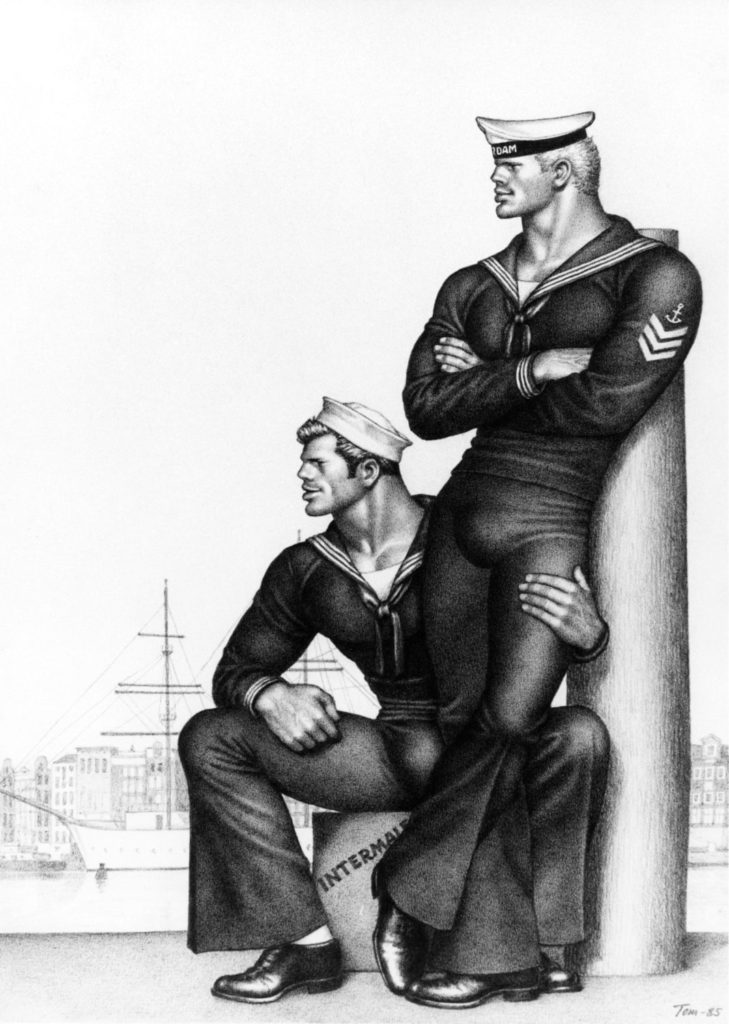
(Courtesy Tom of Finland Foundation)
“Tom went on to give us revolutionary images — he was a liberator. He saw no reason queer men had to fit into the small compartment that society allowed us,” says Sharp. “We were made lesser than — Tom gave us a new vocabulary of who we could be. We could be soldiers, cops, bikers — everything they wouldn’t let us be. We could be strong, we could be powerful — he leveled the straight/queer playing field. For as much as he gave homosexuals positive roles models, the heteronormative sphere now could view us as, well, equal.”
“Tom of Finland was a part of the sexual revolution and the counterculture. His art made people feel OK to fantasize and not fit a social standard of get married, have kids, grow old, die,” concurs Danny Fuentes of Lethal Amounts, an L.A. art gallery with similar ethos. “Tom of Finland started getting published in the mid-’50s in underground zines and rags because ‘gay’ was outlawed in most places. A culture of its own had to be created in order to hide it from the rest of the world that wanted to harm those that identified as gay in the ’50s. Sometimes it’s hard for people to contextualize how outrageous it was to depict two police officers or bikers or military men being homosexual and still masculine.”
While Tom’s artwork was no doubt innovative, it’s fair to question if his men unwittingly promoted the heteronormative image of what a man and masculinity should be. For a gay man who is on the more feminine end of the spectrum, could Tom’s work just be seen as reinforcing toxic masculinity and setting an impossible and unrelatable standard for more feminine gay men? Sharp doesn’t think so. “I think toxic is only when you actually are putting down, demeaning or [lessening] other people. So in other words, masculinity is only achieved by that definition, by suppressing, by demoralizing, by demeaning other people,” he says.
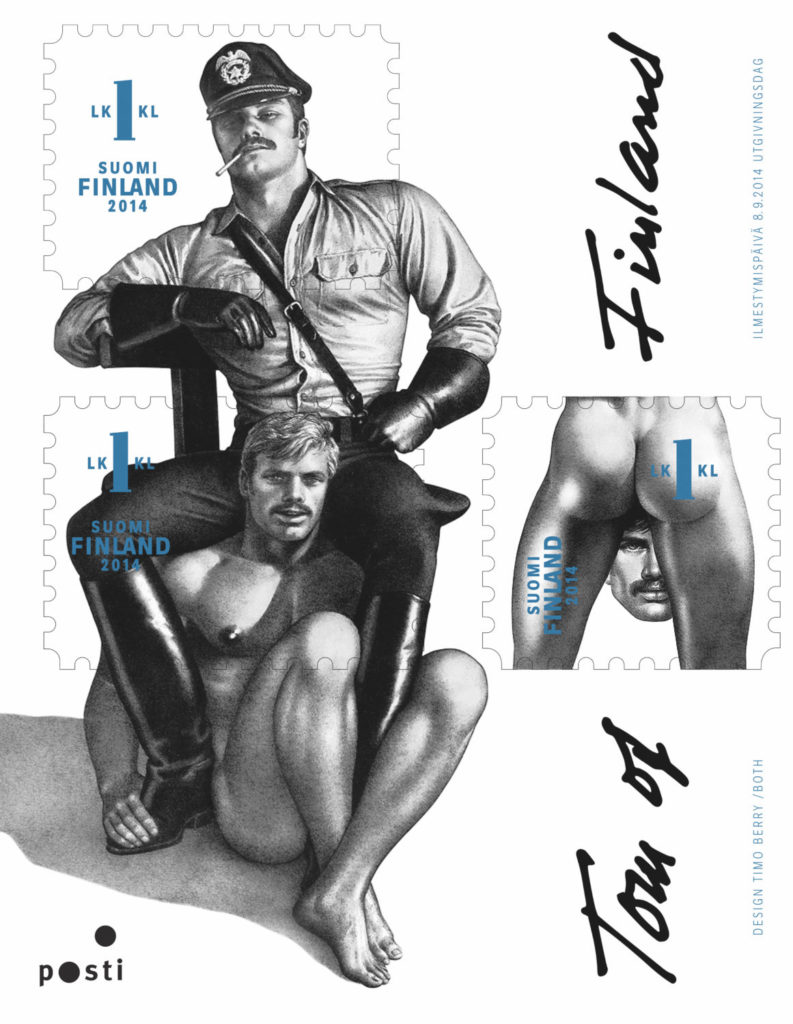
(Courtesy Tom of Finland Foundation)
Laaksonen gave up his job in advertising so that he could devote himself to his art full time in 1973. The landmark 1962 Supreme Court case MANual Enterprises, Inc. v. Day essentially legalized the mailing of male pornographic materials a decade prior, and allowed him the freedom to publish and exhibit his work on a larger scale. In the early ’80s, he came to L.A. at the invitation of Durk Dehner, a gay businessman, film director and publisher. Together they started the Tom of Finland Company so that they could publish approved copies of Tom’s graphic novels and curtail all the bootlegs that were going around. Tom ended up living in L.A. for half of every year for the rest of his life, and each time he came, he would bring more materials with him: drawings, letters, uniforms, his stamp collection. As a means of archiving, they established the Tom of Finland Foundation in 1984, with Laaksonen’s actual house, located in Echo Park, serving as headquarters. It now functions as part museum, part event space and a safe place for the LGBTQ community.
After completely cataloging Tom’s materials, they focused their attention on other artists, giving them support and a space for their works to be shown via art and culture festivals, drawing sessions, and emerging artist competitions. They added an artist-in-residency program, screenings and most recently, a summer music program too.

The Tom House in Echo Park (Henning von Berg).
Rick Castro is one such artist. The foundation formed a strong relationship with the photographer, a third-generation Angeleno from Monterey Park. Working in the wardrobe industry for 15 years before focusing on photography in the mid-’80s, Castro’s work is known for its strong social statements and pushing boundaries. His explorations of various fetish cultures have gotten a lot of attention in particular.
“I personally always identified with fetish, even before I could actually call it that. My draw was [from] BDSM to leather to fetish to that kind of erotic esoteric, which to me goes beyond gay, it’s like your own kind of personal interest,” says Castro. “So that’s what I started to document with my images.”
The photographer, who’s worked with performance art legend Vaginal Davis (their film Fertile Latoya Jackson was just screened as part of the acclaimed queer film series “Dirty Looks”), co-directed and co-wrote the feature film Hustler White (1996) with Bruce LaBruce, and a film about plushies and furries (currently available on World of Wonder’s WOW Presents Plus) also and had his own gallery in Hollywood called Antebellum, which still maintains a popular blog. Castro has been a major proponent of fetish culture in the gay community and beyond for decades and has known Dehner for many years since he published his first book with him in the early ’90s. He’s also shown his work at Tom of Finland events and, more recently, helped produce their art fairs and holds salons at Tom’s House, with anti-censorship as a recurring theme.
“I think that the connection for the Tom of Finland Foundation, what it’s become, what it’s evolved into now is just the place where a lot of people feel safe to express what they don’t think they could express in mainstream everyday life, so it gives them a space to have fantasy,” says Castro.
In April of this year, Castro had one of his first solo shows at the Tom of Finland House, a retrospective called “Rick Castro: Fetish King.” LGBTQ outlet The Advocate advanced the exhibit and posted the article with several images from the show. The more risqué photos required users to press a button confirming they were old enough to view the content; however, when The Advocate posted the story on Castro’s Facebook page, they suspended his account for 30 days. The image Facebook objected to featured two lucha libre wrestlers on top of each other, fully clothed.

(Courtesy Rick Castro)
The Advocate offered to take down the image but Castro strongly objected. “There was not nudity. It was definitely homoerotic, but it was no more homoerotic than a Madonna video,” Castro said. “It was very obvious that because it was two men, that’s why it was removed. If you look at this stuff that’s for heteronormative images, and you look at the exact same thing that a homoerotic might publish, the homoerotic is removed, the heteronormative is still there for the viewing.”
Castro says the hypocrisy shown by Facebook and Instagram (which it owns) goes to a “much deeper, insidious kind of chapter that we’re in. I think it’s really important to fight back,” insists Castro. He decided to write a statement about the Facebook fiasco, which The Advocate published as well, along with a (fully clothed) image of the artist sitting on a bench in Chinatown. When that piece was shared on Facebook by friends, Castro and the outlet itself, it was deemed a violation by Facebook, leading to another 30 day ban. “Now I’m banned for 60 days, meaning I can’t promote my show on social media,” recalls Castro. His curator and gallerist both tried posting the article too, only to be banned along with him. Even Sharp tried posting the piece on Castro’s behalf and was also blocked.
When L.A. Weekly learned of the censorship, it sought to investigate. After culture editor Lina Lecaro reached out to Facebook about the situation, Facebook’s reps reviewed it and determined they were in the wrong, eventually issuing an apology. But by then it was too late — the exhibit was already over. “By the way, since this whole debacle, Facebook has not removed me,” Castro notes. “I’ve been able to post whatever I want there, but on Instagram they’re removing a lot of my images with the same kind of dire warning.”
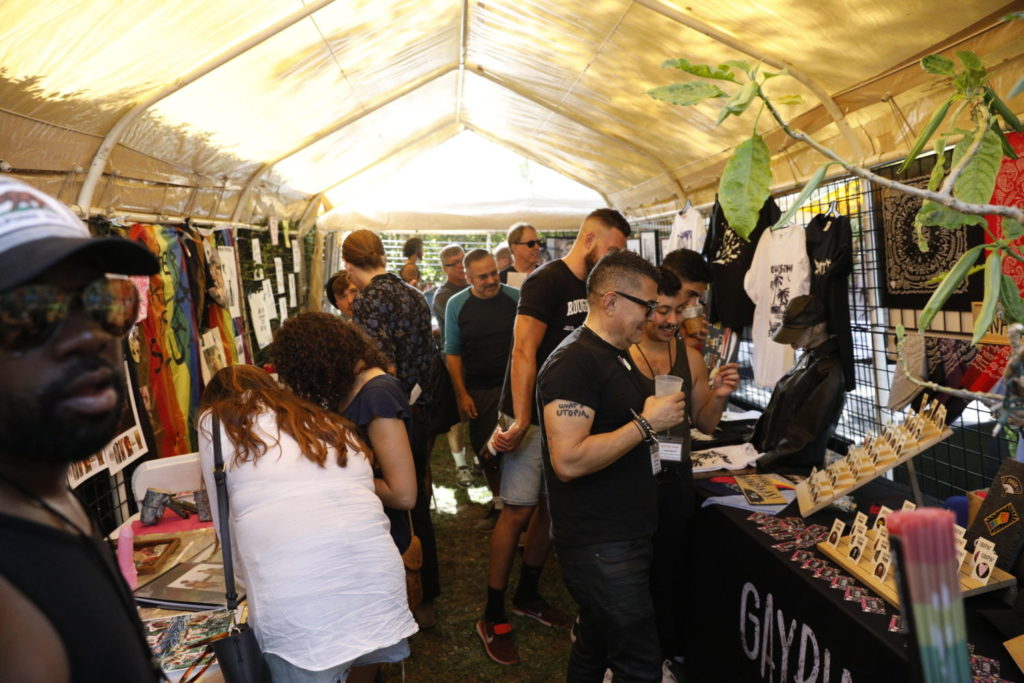
Tom of Finland Art Fair (The Cobrasnake)
“They’re perverting us. It’s the most perverting thing to ask us to self-censor. I mean, that’s the most obscene thing about it, they want us to start thinking the way they think,” Sharp says of Facebook and Instagram’s inconsistent policies. “So it’s very deep and very troubling… and they are making deviants out of what’s innocent. Social media rules are impossible to understand. They make no sense and they’re updating them constantly and not telling you they’re updated.”
As for the foundation’s banishment from Instagram, the image that was apparently the final straw was from an art catalogue for a Denmark art show Tom was included in — one celebrating the end of a ban on visual pornography in that country. Yes, it’s ironic.
According to Instagram, nudity in photos of paintings and sculptures is OK, but it obviously wasn’t in this case. In response, Sharp and Castro presented a panel in October at their art festival, “How Do We Communicate On/With Social Media.” They invited reps from Facebook and Instagram to join the artists, activists, educators and lawyers on the panel. Neither accepted but Instagram did say they would include ToF in an upcoming West Coast discussion that it hosts on posting guidelines for nudity and art. “They had one in New York last month with artists and art workers. It sounds like they want to progress on their policies,” Sharp said hopefully.
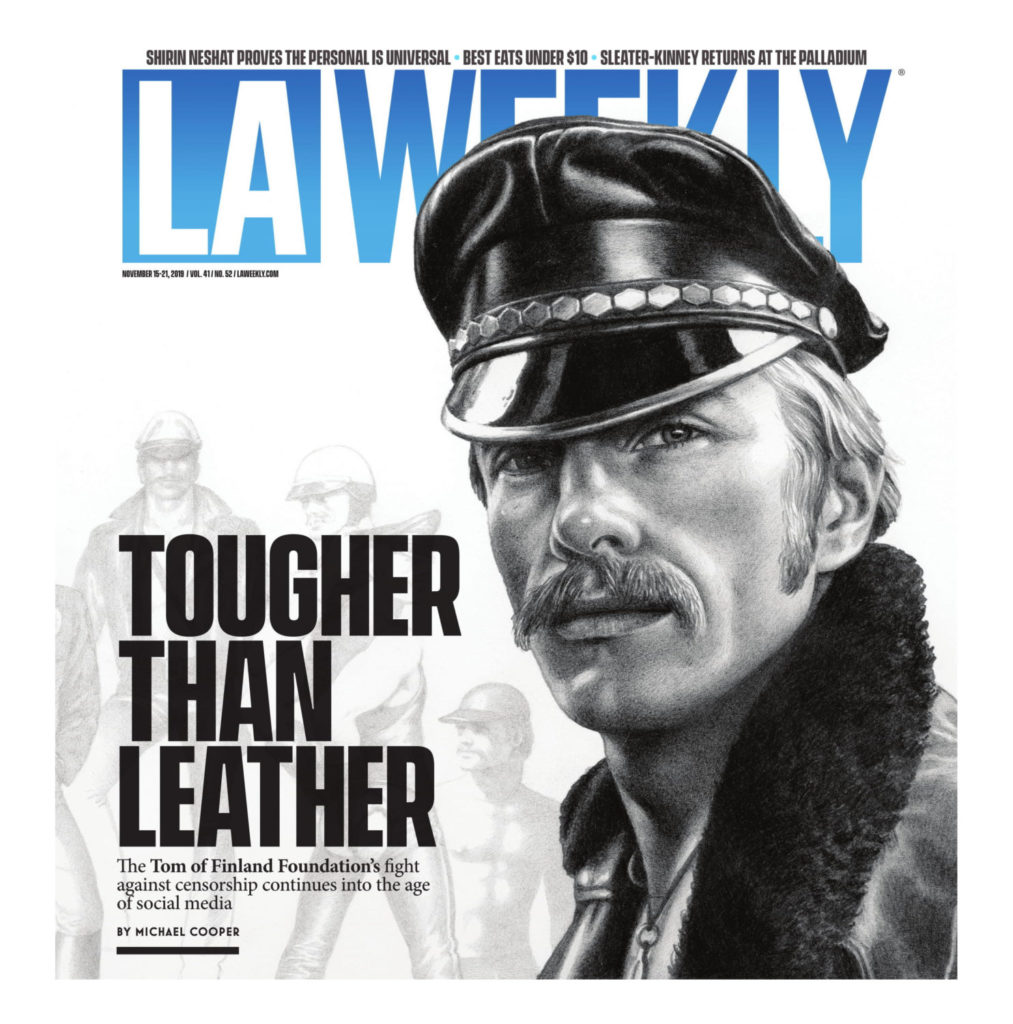
Read this cover story in this week’s print edition.
In light of Mark Zuckerberg’s recent hands-off approach concerning political content, some of which the platform concedes is dishonest, its policing of sexual content feels even more distasteful. While social media platforms should have the freedom to shape their own communities, they should not force-feed us what they think is sexually appropriate. Of course, the way to change policy, be it the government or a big corporation, is to put our money where our mouths are. The alternative is self-censorship, which Sharp sees as “the antithesis of what freedom of expression is all about.”
“To censor is to kill off the voice of a person,” echoes Fuentes, who recently co-presented an art show with ToF from trans icon Genesis P-Orridge. “Art as a whole should never be censored, I still think art is our society’s last sacred thing and I stand with [the] Tom of Finland Foundation in trying to keep art dangerous, provocative and even disturbing, but above all keep the conversation open and ongoing.”
And doing so means involving everyone, beyond the gay, fetish or punk communities, which of course social media makes possible. “An unwritten mission of ours is to make art and beauty a part of your life,” says Sharp. Despite its recent struggles, the group has continued to do just that. Though the internet didn’t exist when Touko Laaksonen created his original images, the fight for them to be seen then versus now isn’t that different. And as long as the foundation continues to fulfill its official mission statement, freedom wins. It reads, “Tom of Finland Foundation shall continue to encourage the work of erotic visual artists regardless of race, creed, religion, gender, sexual identity, medium of expression or any other censoring criteria.”
Tom Of Finland and Lethal Amounts present Sex Cells X Daddywood Fundraiser at Precinct DTLA, 357 S. Broadway; Fri., Nov. 17, 9 p.m. (A portion of the proceeds will go to the Tom Of Finland Foundation for the preservation of erotic art). Info here.
Opening reception for the Foundation’s next artist-in-residence, Bas Koster, takes place Sun., Nov. 24. More info on Tom’s Blog. Follow Tom of Finland on Facebook, Twitter and Instagram.
Advertising disclosure: We may receive compensation for some of the links in our stories. Thank you for supporting LA Weekly and our advertisers.

